I Can’t Believe What My Fiancé Wants to Do With MY Inheritance

Big herds of dinosaurs run through the forest. The temperature rises rapidly, and everything behind them begins to ignite. Some dinosaurs get stuck in swamps and can’t get out. Pterodactyls fly over their heads as they try to avoid the blast wave that will soon cover the Earth.
This event happened about 66 million years ago. It wiped out almost every living thing on Earth. Birds and flying dinosaurs were just about the only ones who could survive the most massive extinction event ever. Hey don’t blame me. I wasn’t around then.
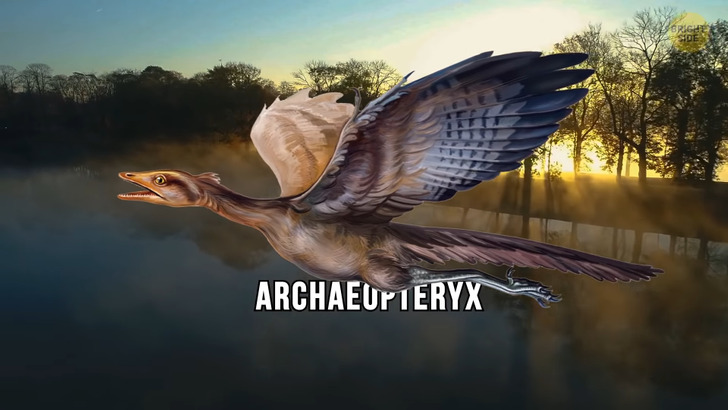
Let’s go down their evolutionary tree to look at the world’s first bird — Archaeopteryx. It was about the size of a modern raven, but it looked like a small dinosaur with feathers. It had many small conical teeth, almost like alligators. It’s because Archaeopteryx was closer to reptiles than to birds. However, its brain was three times larger than that of these reptiles. Although it had wings with feathers, it could hardly fly like modern birds. Its shoulder joints didn’t allow it to lift its wings above its back. So it couldn’t make a full wingbeat. Most likely, Archaeopteryx was capable of gliding flights with small wing flaps. Evolution has led to more evolved species capable of full flight.
Pterodactyls. These guys had no feathers, but membranes made of skin and muscle. Its wingspan was about the length of a human leg. It could fly perfectly and catch fish and small animals. Although flying dinosaurs could easily outrun terrestrial predators like velociraptors and T-Rexes, most of them didn’t make it through the impact of a giant meteorite. Let’s look at this event step by step to see how they got to our time. Ten minutes before the meteorite crash. A massive rock about the size of Manhattan Island is moving towards Earth in space. It weighs 460 trillion tons. That’s like three trillion blue whales, the heaviest mammals that ever lived on Earth. And it’s approaching our planet at 12 miles per second. At that speed, it could cross the Atlantic Ocean in just 4.5 minutes. That’s twice as fast as our modern spacecraft can fly.
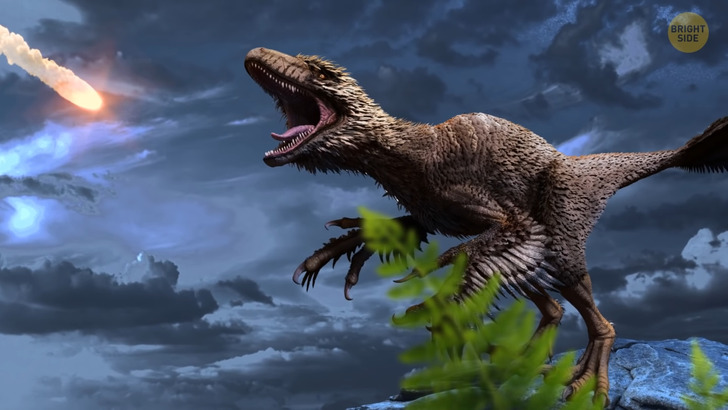
Five seconds before the meteorite crash. Ooh, this is getting tense. The Earth’s gravitational force continues to pull the giant meteorite. It blows a hole in our atmosphere and creates a popping sound so loud you could hear it on the other side of our planet. All the animals on our planet wake up in a panic. They lift their heads up and see a huge rock that begins to burn through the air. Smaller fragments start to break away from the main meteorite. This fire is so bright that it shines almost like the Sun. Flying dinosaurs and other ancestors of modern birds are the first to sense danger. They make a beeline to the sky and try to fly as far away from the impact site as possible to save their lives.
The moment of impact. The colossal mass and velocity of the meteorite give it an enormous amount of energy. As soon as it touches the Earth, it causes an explosion of 150 trillion tons of TNT. The blast wave literally rips out chunks of our planet and throws them up. A huge wall of energy begins to move from the point of impact in all directions. It snatches the trees out with the roots and pushes them to the ground like dominoes. The shock wave completely wraps around our planet. This energy turns into heat. Everything around the impact site begins to ignite, green jungles and trees turn to smoldering charcoal in seconds. The ground and rocks simply evaporate.
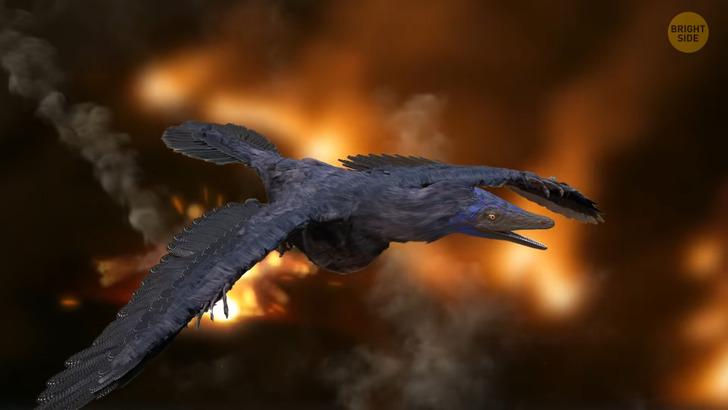
The collision caused a massive earthquake. Some dinosaurs may have fallen into cracks that appeared in the ground. A strong earthquake caused a tsunami with waves higher than the Empire State Building. Dinosaurs that weren’t trapped in the burning forests were washed away by the enormous waves. The dinosaurs of North America try to escape by running to the North. But the blast wave inevitably catches up with them. Flying dinosaurs have no problem with earthquakes or tsunamis. They fly high enough to avoid the giant waves. But they will have to contend with continuously falling meteorite debris.
Five minutes after the meteorite crash. A meteor shower of giant rock fragments continues to fall to Earth. Some meteorites were the size of a car; others were more like a large building. Ashes and dust rise into the air. Their temperature is so high that they melt and turn into liquid lava and then fall back to Earth, causing more fires. Meteor showers caused trouble for flying dinosaurs too. They have to maneuver and dodge the falling red-hot rocks. The high temperatures are a huge problem for them because it might make them lose feathers. With no feathers, they aren’t able to fly.
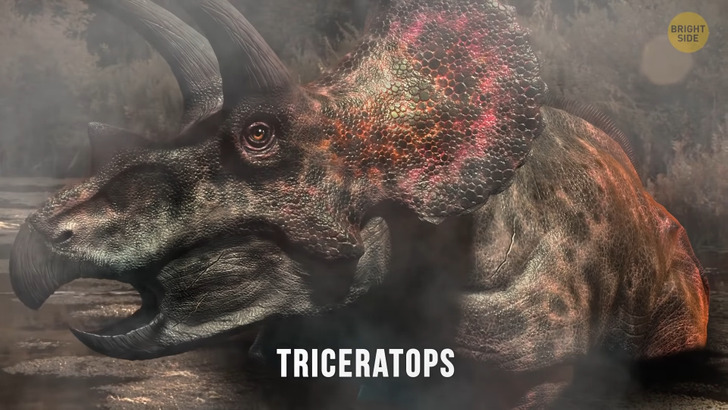
10 hours after the meteorite crash. The dinosaurs continuously ran North all this time. They found themselves in unfamiliar territory with many swamps. Giant dinosaurs like T-Rexes have legs as long as an adult’s human height. They have a chance to get through this terrain. But if they fell, they could never get back up. The smaller dinosaurs, like Triceratops, had short legs and couldn’t go through the dense swamps.
1 month after the meteorite crash. 15 trillion tons of ash were ejected into our atmosphere. A giant cloud blocked the Sun, and the Earth was immersed in complete darkness. Surviving plants couldn’t feed on the sun’s energy and stopped producing oxygen. Surviving dinosaurs can hardly breathe because of the lack of air and a large amount of dust. The lack of sunshine in the sky made phytoplankton disappear. Many marine animals were left without their only source of food. The dust and ashes in the atmosphere prevent our planet from getting heat from the Sun, and the temperature here is beginning to drop.
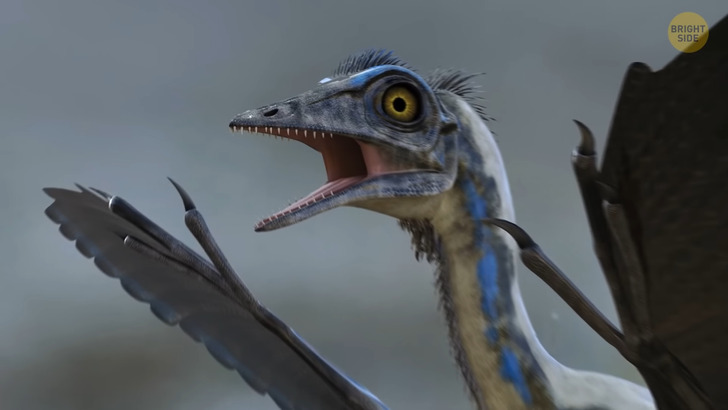
The place where the meteorite fell was rich in sulfur. This toxic acid evaporated at the time of the impact and formed in clouds. Now there are acid rains on Earth. Flying dinosaurs now have to hide from these rains. They have to stay in caves and can’t go outside to get some food. So far, a large number of terrestrial and flying dinosaurs have survived. They come out to see the aftermath of the disaster. The site of the impact was in present-day Mexico, the Yucatán Peninsula. The Chicxulub crater is located here. It’s about 93 miles wide, like half of all of Lake Michigan! And it’s 12 miles deep. You could plunge the whole Mount Everest in there, and there would still be 6.5 miles of available space.
It wasn’t the impact itself that made the dinosaurs disappear. The fire destroyed most of the plants the herbivorous dinosaurs ate. With no food, their numbers dwindled rapidly. Predatory dinosaurs had nothing to eat either. Acid rain and the disappearance of phytoplankton threatened all marine life. Even though birds managed to avoid the blast waves and tsunami, they were short of food too. About 80% of all birds didn’t make it to the end of the extinction event.
The problem was that all the forests on Earth were wiped out. Most birds would nest and live in trees. Besides that, the forests were always full of food, from all kinds of ants and termites to flying insects and small mice. So only those species that lived on the ground and could fly well survived. Most likely, they fed on the seeds of small surviving plants. This habit made flying dinosaurs lose their teeth during evolution. Instead of jaws with a bunch of sharp teeth, they got long beaks to grab tiny seeds from the ground.
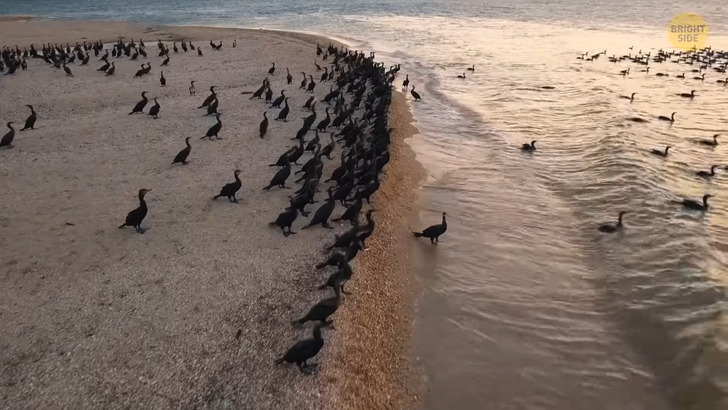
Although Earth looks like a terrible place to live now, there’s an evolutionary boom for birds. They have to travel long distances in search of food. Their wings get stronger. They also feel safe from predators who regarded them as food before. No T-Rex now catches a sleeping bird off guard. About 1,000 years after the collision, the first dense forests appear. It gives another big boost to evolution. A million years later, forests full of food are populated by the ancestors of modern mousebirds. And 65 million years later, in modern times, we have about 10,000 species of birds. Pigeons, crows, eagles, and hawks. Even penguins. These are all descendants of the dinosaurs.
But there were other survivors. Some alligator and crocodile ancestors were able to adapt to changing conditions. About 80% of turtle species managed to survive the mass extinction, and now their descendants live among us. Snakes and lizards were also able to wait out the hard times in their burrows. Even some mammals, like monotremes, survived. This hedgehog-sized animal was able to continue to evolve. Many millions of years later, these mammals evolved into primates, which later gave life to modern humans. Much, much later, came the iPhone.











